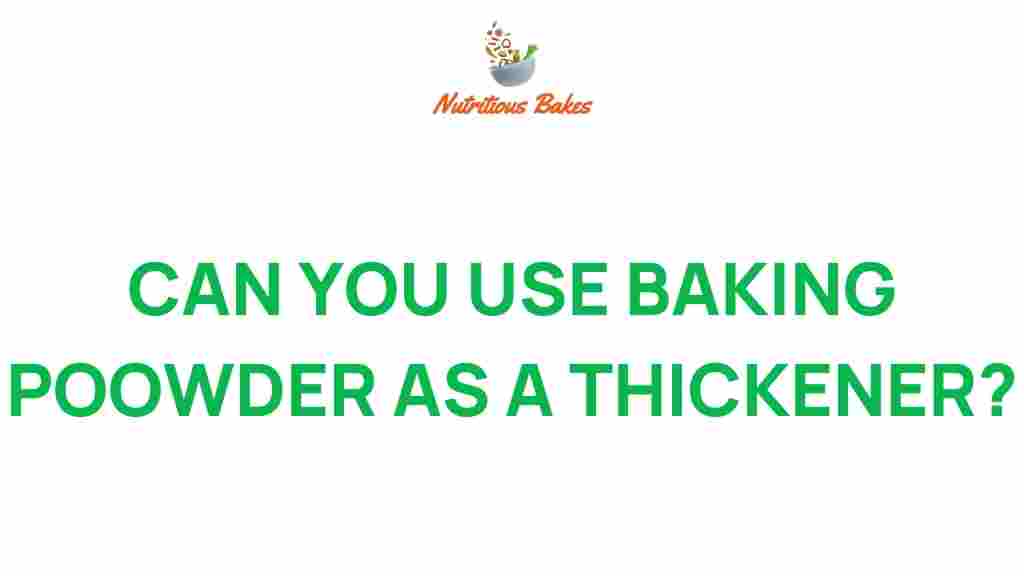The Surprising Role of Baking Powder: Can It Be a Thickener?
Baking powder is often relegated to the role of a leavening agent in baked goods, but its culinary applications extend far beyond that. Many home cooks and professional chefs alike may overlook the potential of baking powder as a thickener. In this article, we’ll explore the unexpected uses of baking powder in cooking, its role as a thickener, and provide valuable kitchen tips, hacks, and food science insights to help you maximize this versatile ingredient.
Understanding Baking Powder
Before diving into its thickening capabilities, let’s clarify what baking powder is. Baking powder is a combination of an acid (usually cream of tartar), a base (typically baking soda), and a moisture-absorbing agent (like starch). When baking powder is mixed with moisture and heat, a chemical reaction occurs, producing carbon dioxide, which makes baked goods rise.
Can Baking Powder Act as a Thickener?
While baking powder is not traditionally recognized as a thickener like cornstarch or flour, it can still perform this role under certain conditions. Here’s how:
- Creating a Foam: When baking powder is activated in liquid, it creates a foam that can contribute to the thickness of a mixture.
- In Combination with Other Ingredients: Baking powder can be used alongside other thickeners to enhance texture and stability in recipes.
However, it’s crucial to note that baking powder should not be the sole thickening agent. Instead, think of it as an enhancer that can improve the thickening power of other ingredients.
Culinary Uses of Baking Powder as a Thickener
Here are several culinary situations where baking powder can serve as a thickening agent:
- Soups and Sauces: When added to soups or sauces, baking powder can help achieve a slightly thicker consistency while adding a subtle flavor.
- Batter and Doughs: In batters for pancakes or fritters, baking powder contributes to a fluffier texture, which can mimic thickening.
- Custards and Puddings: Baking powder can be used in custards to create a lighter texture, making them feel thicker without adding density.
Step-by-Step Guide to Using Baking Powder as a Thickener
To effectively use baking powder as a thickener in your recipes, follow these steps:
- Choose Your Recipe: Identify a recipe that requires thickening, such as a sauce or batter.
- Measure Carefully: Use about 1 teaspoon of baking powder for every cup of liquid. Too much can lead to an unpleasant taste.
- Combine Ingredients: Mix the baking powder with your dry ingredients (like flour or cornstarch) or add it directly to your liquid ingredients.
- Monitor Cooking: Allow the mixture to cook sufficiently to activate the baking powder and achieve the desired thickness.
Cooking Tips for Using Baking Powder
Here are some cooking tips to keep in mind when using baking powder as a thickener:
- Use Fresh Baking Powder: Ensure your baking powder is fresh. Old baking powder may not react properly, failing to thicken your dish.
- Combine with Other Thickeners: For best results, combine baking powder with other thickeners like cornstarch or flour.
- Adjust Cooking Time: Baking powder may require additional cooking time to fully activate and thicken your dish.
Kitchen Hacks with Baking Powder
Beyond thickening, here are some kitchen hacks that utilize baking powder:
- Fluffier Pancakes: Add a bit more baking powder to your pancake batter for extra fluffiness.
- Softening Vegetables: A pinch of baking powder can help soften vegetables when boiling, making them cook faster.
- Cleaning Agent: Baking powder can be a gentle abrasive cleaner for pots and pans.
Ingredient Substitutes for Baking Powder
If you don’t have baking powder on hand, there are several substitutes you can use:
- Baking Soda and Cream of Tartar: Mix 1 part baking soda with 2 parts cream of tartar to replace baking powder.
- Buttermilk and Baking Soda: Use 1/2 cup of buttermilk with 1/4 teaspoon of baking soda to substitute for 1 teaspoon of baking powder.
- Yogurt and Baking Soda: Similar to buttermilk, yogurt can be used with baking soda for a tangy substitute.
Troubleshooting Tips
When using baking powder as a thickener, you may encounter some common issues. Here are tips for troubleshooting:
- Too Much Thickness: If your dish becomes overly thick, try adding a small amount of liquid to loosen it up.
- Unpleasant Flavor: If you notice a bitter flavor, reduce the amount of baking powder used in your recipe.
- Insufficient Thickening: If the mixture isn’t thickening as expected, ensure you’ve allowed enough cooking time for the baking powder to activate.
Conclusion
Baking powder is a versatile ingredient that can do much more than help your cakes rise. Its potential as a thickener opens up a world of culinary possibilities. By understanding its properties and following our cooking tips, kitchen hacks, and troubleshooting advice, you can enhance your dishes effectively. Experiment with baking powder in your next recipe, and discover new ways to use this common pantry staple.
For more cooking tips and kitchen hacks, visit our recipe blog. To learn more about the science behind baking and cooking, check out this great resource on food science.
This article is in the category Tips and created by NutritiousBakes Team
